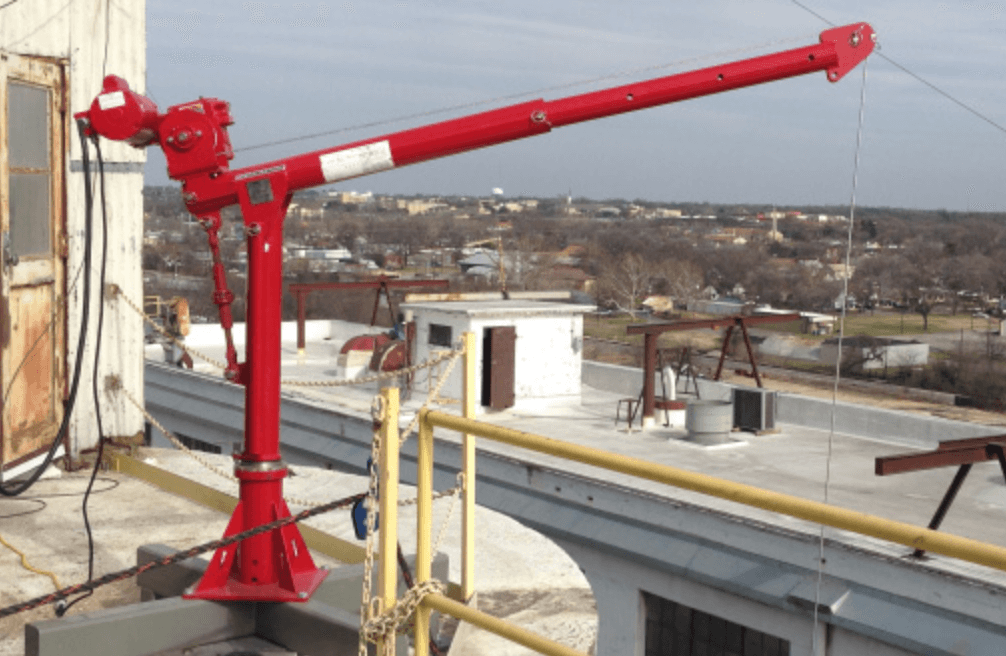What Is Davit Crane Load Capacity?
In basic terms, load capacity is the maximum rated load for the davit, including the safety margin, engineering, and testing standards. In order to maintain a safe jobsite and avoid the issues caused by overloading your crane, every davit should always be used as rated and according to the installation and operating instructions.
Why Load Capacity Matters for Your Lifting Application
So what happens if you choose a crane that doesn’t have enough lifting capacity? First and foremost, the risk of catastrophic failure increases dramatically, posing health and safety risks to everyone working with or near the crane. Overloading can cause irreversible damage to the davit’s frame and the winch, reduce durability, break the chain or cable, and shorten the crane’s lifespan.
What Determines Required Load Capacity?
Multiple factors go into the load capacity your crane will need. First and foremost, the load capacity of your crane must be more than the heaviest load you will lift. Related to the weight of the load is the type of load that is being moved. For instance, dynamic loads — loads that could be affected by outside forces, like movement caused by wind, additional debris on wastewater pumps, or vibrations — can limit load capacity. On the other hand, static loads that are not going to be subjected to additional variables will not affect load capacity.
Finally, the angle and reach of your boom will impact your total load capacity. The more horizontal and longer your boom needs to be, the less lifting capacity you’ll have and a higher rating you’ll need to lift heavy loads. In contrast, if you can keep your boom short and at an angle that is closer to vertical, your crane can handle loads that are closer to its listed lifting capacity. Knowing the required hook height and reach is equally as important as knowing your load capacity needs — there’s no use having a crane that can handle the load but can’t actually reach it or get it where it needs to go. Hook height and reach requirements may lead you to choose a crane with a higher maximum load rating than you strictly need, but having a bit more lifting power around shouldn’t be a problem.
Calculating the Right Capacity for Your Needs
When figuring out the capacity of crane that you need, be sure that you have this information:
- The weight of the heaviest load that your crane will lift
- Reach, hook height, and lift distance
- Crane load charts (see below)
- Crane cut sheets

If you aren’t sure how to find the ideal crane for your needs, you can use Thern’s product selector tool to find the perfect match.
Matching Load Capacity to Davit Crane
Finding the right davit can be a process, but there are some good rules of thumb. Heavier loads will generally require a stationary model, like the Captain 4000, which has a 5,500 lbs load capacity, or the Admiral 3000 and its 3,000 lbs capacity. On the other hand, if your job requires maneuverability and lifting lighter loads, a portable davit could be ideal. Thern has portable davits with lifting capacities that range from 500 to 2,000 lbs, giving you a wide range of cranes to choose from to find the right fit. If you’re looking for additional guidance, you can check out our ultimate guide to davit cranes for more resources.
Working With a Trusted Crane Supplier
When it’s time to choose a davit for a project or worksite, consulting with an expert is one of the best ways to ensure you get a crane with the appropriate load capacity. Thern has decades of experience providing top-quality lifting equipment for industries and applications of all kinds, including custom solutions that are designed just for your project. If you want to make use of our expertise to pick the perfect davit or explore custom options, get in touch with us today.
